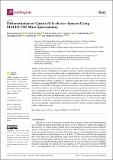Differentiation of Gastric Helicobacter Species Using MALDI-TOF Mass Spectrometry
Author(s)
Berlamont, Helena; De Witte, Chloë; De Bruyckere, Sofie; Fox, James G.; Backert, Steffen; Smet, Annemieke; Boyen, Filip; Haesebrouck, Freddy; ... Show more Show less
Downloadpathogens-10-00366-v2.pdf (4.134Mb)
Publisher with Creative Commons License
Publisher with Creative Commons License
Creative Commons Attribution
Terms of use
Metadata
Show full item recordAbstract
Gastric helicobacters (<i>Helicobacter</i> (<i>H.</i>) <i>pylori</i> and non-<i>H. pylori Helicobacter</i> species (NHPHs)) colonize the stomach of humans and/or animals. <i>Helicobacter</i> species identification is essential since many of them are recognized as human and/or animal pathogens. Currently, <i>Helicobacter</i> species can only be differentiated using molecular methods. Differentiation between NHPHs using MALDI-TOF MS has not been described before, probably because these species are poorly represented in current MALDI-TOF MS databases. Therefore, we identified 93 gastric <i>Helicobacter</i> isolates of 10 different <i>Helicobacter</i> species using MALDI-TOF MS in order to establish a more elaborate <i>Helicobacter</i> reference database. While the MALDI Biotyper database was not able to correctly identify any of the isolates, the in-house database correctly identified all individual mass spectra and resulted in 82% correct species identification based on the two highest log score matches (with log scores ≥2). In addition, a dendrogram was constructed using all newly created main spectrum profiles. Nine main clusters were formed, with some phylogenetically closely related <i>Helicobacter</i> species clustering closely together and well-defined subclusters being observed in specific species. Current results suggest that MALDI-TOF MS allows rapid differentiation between gastric <i>Helicobacter</i> species, provided that an extensive database is at hand and variation due to growth conditions and agar-medium-related peaks are taken into account.
Date issued
2021-03-18Department
Massachusetts Institute of Technology. Division of Comparative MedicinePublisher
Multidisciplinary Digital Publishing Institute
Citation
Pathogens 10 (3): 366 (2021)
Version: Final published version